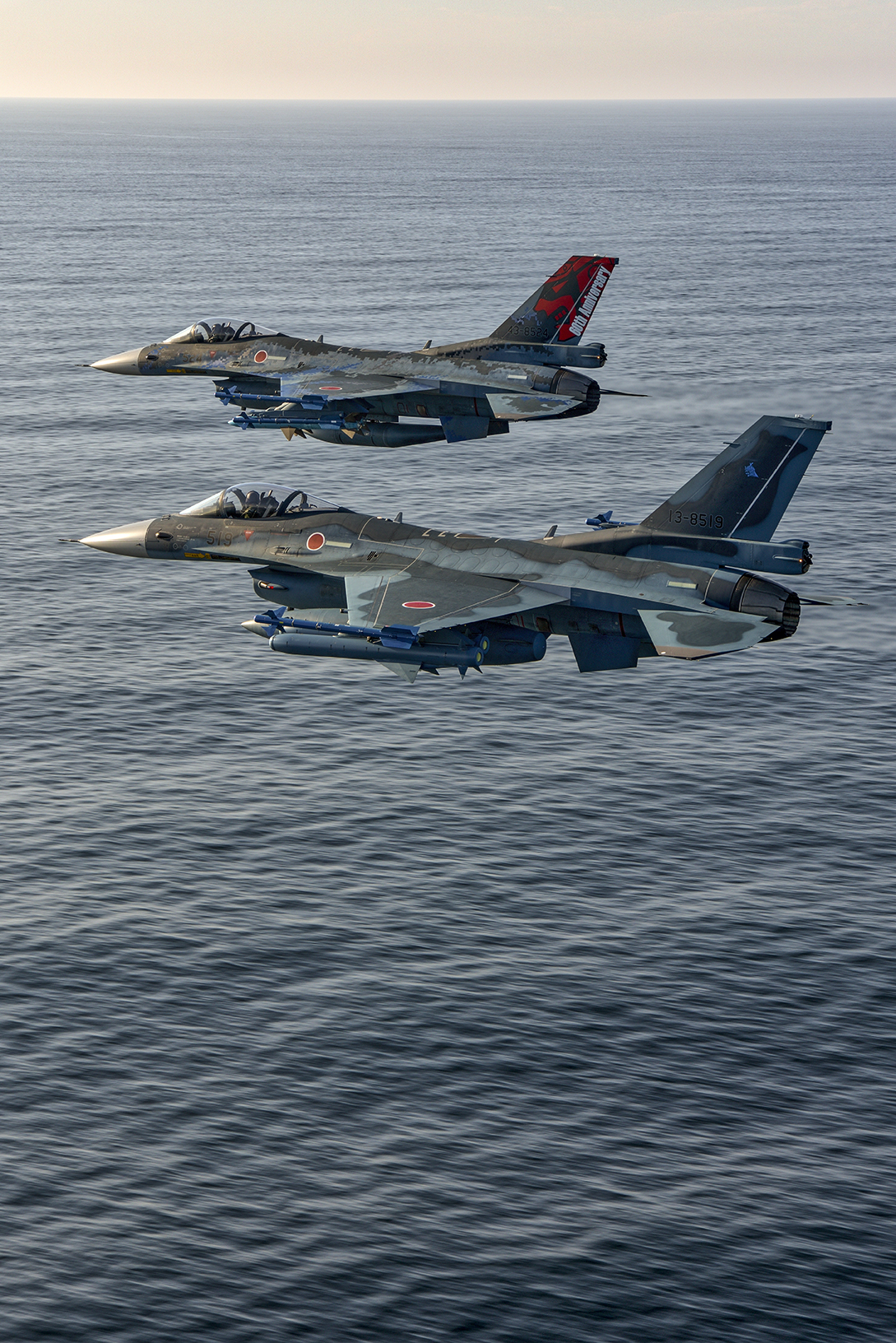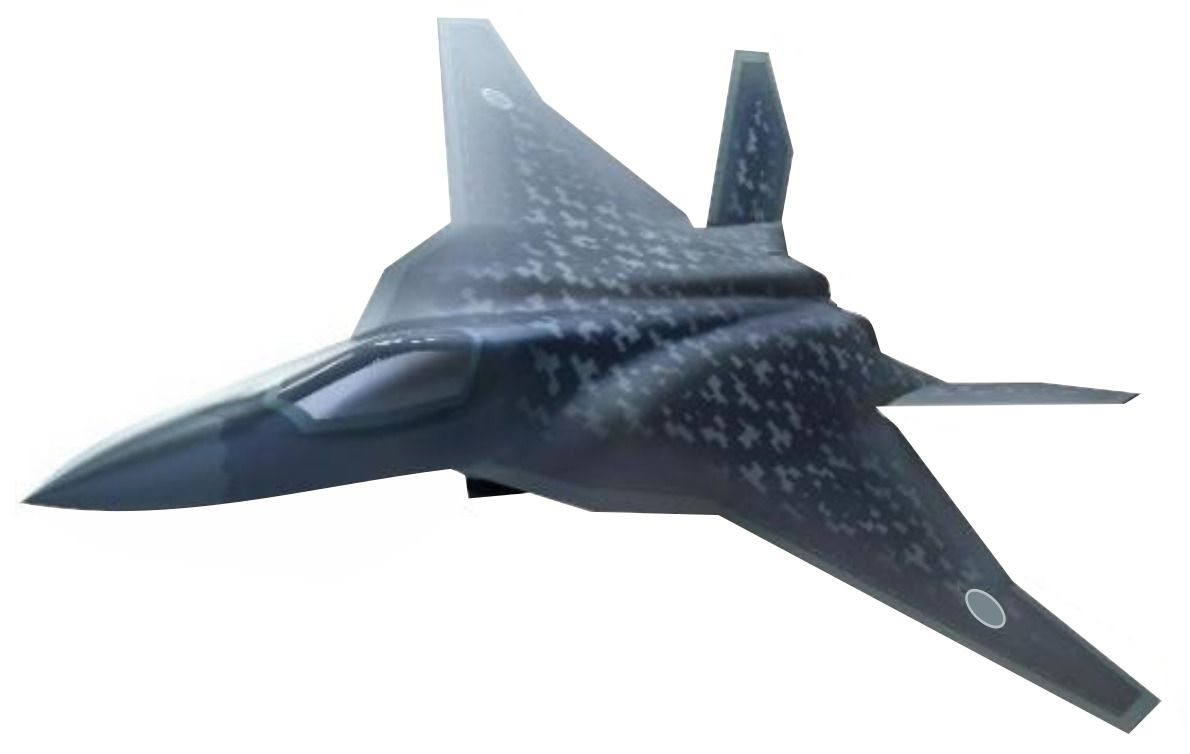F-2 Aircraft - The F-2 Support Fighter is a multirole single-engine fighter aircraft produced for the Japan Air Self Defense Force (JASDF). It was jointly developed in the mid to late 1980s and jointly produced in the early 1990s by Mitsubishi Heavy Industries (MHI, the main Japanese contractor), Lockheed Martin Aeronautics (MHI's main US subcontractor), and other Japanese industries. and Americans. . The program remains a hallmark of trust, technology transfer, and division of labor between Japan and the US.
Based on the Lockheed Martin F-16 Fighting Falcon design, the F-2 is capable of both air-to-air and air-to-surface roles, though it is optimized for the latter role, to protect Japan's shipping lanes. Many of the aircraft's innovative systems, including the fly-by-wire flight control system and integrated electronic warfare system, were developed in Japan. The F-2 was also the first production fighter to be equipped with active electronically scanned array (AESA) radar. In 2015, the F-2 became the eighth aircraft platform equipped with Lockheed Martin's Sniper® Advanced Targeting Pod.
F-2 Aircraft

The F-2 has a wing area that is increased by about 25 percent over the F-16. The larger wing allows for more internal fuel storage and two more weapons stowage stations than the F-16. Japan chose to fabricate the wing substructure using graphite epoxy and using state-of-the-art co-curing composite technology to maximize strength and minimize weight. In addition to the larger wing area, the F-2's fuselage is about 17 inches longer than the F-16's fuselage. The horizontal tails are also larger.
File:mitsubishi F 2 Fighter 05.jpg
Significant features of the program are technology transfer and job sharing between Japan and the United States. Japan is responsible for the production of about 60 percent of the aircraft, and the United States is responsible for the production of about 40 percent.
A Japan Air Self Defense Force Mitsubishi F-2 support fighter takes off from the runway at Andersen Air Force Base, Guam, June 13 as part of Exercise Cope North. The fighter, from the 3rd Squadron at Misawa Air Force Base, Japan, is making JASDF history as this is its first deployment outside of Japan and the first time the aircraft will drop live munitions on a fixed target. (US Air Force photo/Navy Corporal Ashley Bryant)
Two Mitsubishi F-2s sit on the flight line June 13 at Andersen Air Force Base, Guam, awaiting takeoff. The F-2s are part of the Japan Air Self-Defense Force's historic deployment from Misawa Air Base in Japan. This Cope North exercise marks the first time the F-2 will be deployed outside of Japan and the first time it will drop live munitions on a stationary target. (US Air Force photo/Navy Corporal Ashley Bryant) The Japanese government plans to replace the aging Japan Air Self-Defense Force (ASDF) F-2 fighter jets by 2035 (Reiva 17) and the final decision on which country Japan will partner with in a joint development program will be made by the end of 2020.
The government's 2018-drafted medium-term defense program, covering the five-year period beginning in fiscal year 2019, explicitly calls for a "Japan-led development project" of the F-2 successor as a central tenet of the project. . Prototype production is scheduled to begin in 2024.
F 2 Support Fighter
Earlier this year, the government made a political decision in favor of establishing a joint working group made up of companies from the two countries of Japan and the United States.
The Ministry of Defense is also negotiating with the UK on possible details of a joint project led by Japan.
Tokyo will make a final decision later this year on which country to partner with for the project.

Unlike its predecessor, the new generation ASDF main fighter will be developed as Japan's first domestically produced fighter with international participation. It would include an advanced stealth sensor that would be nearly invisible to radar.
Dassault Mirage F2
Other key elements of the plan call for the design to focus on air-to-air combat effectiveness, with features such as low observability, combat capability within a network of self-defense forces, and interoperability with the US military. Design development begins during the current fiscal year (before March 31, 2021).
The plan foresees that the next-generation aircraft will begin to be used from 2035, when about 90 F-2s will begin to be decommissioned. In the fiscal year 2020 budget, around ¥28 billion was allocated to start the initial design phase of the envisioned combat system.
Britain had plans to develop a new type of fighter around the same time as Japan's next-generation fighter development program. So the Japanese government was initially inclined to undertake a joint development plan with Britain, believing that a joint Japanese-British programme, as compared to a Japanese-American one, might make it easier for Japan to continue with a program in which Japan played a major role. leadership role. .
Furthermore, Brexit makes it less likely that the UK will push for further European cooperation on such a project, which is believed to make the Tokyo government more comfortable.
Mitsubishi F 2 Viper Zero Two Seater Version 3d Model In Fighter 3dexport
On the other hand, interoperability with the US is one of the requirements of the program and since the end of 2019 a series of detailed consultations between the Japanese and US governments have been taking place, focused on:
Ultimately, the Japanese government is expected to choose a partner that will make it easier for Japan to secure its leading role in the project while enhancing defense cooperation and maintaining close relations with both countries.
Related Topics: China's territorial expansionism, defense cooperation, F-2f-2 fighter jet replacement, Japan Air Self-Defense Force, Japan Interoperability, led by Japan-UK. Japan-US CollaborationJASDNext Generation FighterRegional Security

Kishida signs defense pact with Britain to counter threats from China Japan-UK relations enter a new phase with Defense Pact Joint fighter training exercise "Veer Guardian" held by Japan and India in the Hyakuri airbase China's railway project in Indonesia Promised a lot but delivered little North Korea's advanced nuclear policy poses a threat to Northeast Asia EDITORIAL | Japan's national security strategy fulfills its duty to its people The Mitsubishi F-2 is a multi-role fighter derived from the General Dynamics F-16 Fighting Falcon, produced by Mitsubishi Heavy Industries and Lockheed Martin for the Japan Air Self-Defense Force , with a 60/40 production split between Japan and the United States. The basis of the F-2 design is the F-16 Agile Falcon, an unsuccessful bid by Geral Dynamics to provide a low-cost alternative to the competing Advanced Tactical Fighter (ATF). Production started in 1996 and the first aircraft entered service in 2000. The first 76 aircraft entered service in 2008, with a total of 98 aircraft produced. The first active electronically scanned array (AESA) radar on a fighter aircraft was the J/APG-1 introduced on the Mitsubishi F-2 in 1995.
F 2 Mitsubishi Hi Res Stock Photography And Images
The F-2 is nicknamed the "Viper Zero", a reference to the unofficial nickname of the F-16 "Viper" and the Mitsubishi A6M Zero.
JASDF and its contractors considered developing a made-in-Japan replacement for the aging Mitsubishi F-1 fighter as early as 1981. The official feasibility study began in 1985.
Japan's initial intentions to develop the aircraft domestically were based on Japan's earlier success in producing the F-15J fighter under license from McDonnell Douglas.
The Japanese contractors argued that they had to build a new aircraft from scratch to develop the skill of their engineers and, in turn, develop the Japanese aircraft industry.
Jasdf Japan Mitsubishi F 2 A/b F 16 Derivative Model Art Profile Free Us Mailing
When the program began to take formal shape in 1985, several US officials expressed concern that the program would result in inferior aircraft and weaken the US-Japan defense relationship. Pentagon officials pushed for the co-production or joint development of an aircraft based on the F-16 or F/A-18 platform, because they believed that Japan would not agree to buy US aircraft.
In early 1987, the United States, through Caspar Weinberger and other administration officials, began to formally press Japan to pursue the project as a joint US-Japan bilateral development.
The timing of this lobbying coincided with the height of "Killing Japan" in the United States: the Toshiba-Kongsberg scandal, in which Toshiba was found to have sold propeller grinders to the Soviet Union in violation of COCOM sanctions, broke out. went public in May. 1987. Japan's negotiating position changes amid the risk of worsening US-Japan relations.

Under a memorandum of understanding signed in November 1988, General Dynamics will provide its F-16 Fighting Falcon technology to Mitsubishi Heavy Industries and will perform up to 45 percent of the development work as a joint prime contractor.
Cheetah F.2 Air Defense Fighter By Stupolevbear On Deviantart
On the US side, senior officials in the US Department of State and Department of Defense supported the project as a means to give the US access to Japanese technology and as a means to strengthen relations between the US and Japan, but the Commerce Department and many members of Congress opposed the project because of the risk of Japan competing with US aerospace companies.
Opponents in Congress argued that Japan should buy US planes to make up the trade deficit between the two countries.
After George H. v. Bush took office as President of the United States in January 1989, the United States government responded to internal criticism of the agreement by seeking "clarification" of the terms of the Memorandum of Understanding, which the Japanese government viewed as an attempt to renegotiate it.
Aircraft f 35, f 102 aircraft, f-111 aircraft pictures, f aircraft, f 16 fighter aircraft, f-100 aircraft, f-2 aircraft, f 15 aircraft, f-14 aircraft, f 4 phantom aircraft, f 35 fighter aircraft, f&e aircraft maintenance
0 Comments